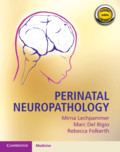Book contents
- Perinatal Neuropathology
- Perinatal Neuropathology
- Copyright page
- Contents
- Preface
- Acknowledgments
- Abbreviations
- Section I Techniques and Practical Considerations
- Section 2 Human Nervous System Development
- Section 3 Stillbirth
- Section 4 Disruptions / Hypoxic-Ischemic Injury
- Section 5 Malformations
- Section 6 Perinatal Neurooncology
- Section 7 Spinal and Neuromuscular Disorders
- Section 8 Eye Disorders
- Section 9 Infections: In Utero Infections
- Section 10 Metabolic / Toxic Disorders: Storage Diseases
- Storage Diseases
- Kernicterus
- Mitochondrial Diseases
- Maternal Toxin Exposure
- Chapter 63 Ethanol and Other Agents
- Section 11 Forensic Neuropathology
- Appendix 1 Technical Considerations in Perinatal CNS
- Index
- References
Chapter 63 - Ethanol and Other Agents
from Maternal Toxin Exposure
Published online by Cambridge University Press: 07 August 2021
- Perinatal Neuropathology
- Perinatal Neuropathology
- Copyright page
- Contents
- Preface
- Acknowledgments
- Abbreviations
- Section I Techniques and Practical Considerations
- Section 2 Human Nervous System Development
- Section 3 Stillbirth
- Section 4 Disruptions / Hypoxic-Ischemic Injury
- Section 5 Malformations
- Section 6 Perinatal Neurooncology
- Section 7 Spinal and Neuromuscular Disorders
- Section 8 Eye Disorders
- Section 9 Infections: In Utero Infections
- Section 10 Metabolic / Toxic Disorders: Storage Diseases
- Storage Diseases
- Kernicterus
- Mitochondrial Diseases
- Maternal Toxin Exposure
- Chapter 63 Ethanol and Other Agents
- Section 11 Forensic Neuropathology
- Appendix 1 Technical Considerations in Perinatal CNS
- Index
- References
Summary
Brain development is a biologically complex process. Many of the metabolic, signaling, and cell adhesion requirements are sensitive to the nutritional and chemical environment. The field of developmental neurotoxicology/neuroteratology is devoted to determining the risk of adverse neurological outcomes in the offspring of pregnant females exposed to exogenous substances (1–7). Hundreds of agents are known or believed to cause human malformations. This chapter will focus on those with an impact on the human nervous system. Those with potential for major structural effects that could cause fetal death or would be obvious in the perinatal period are critical, but we also include a discussion of drugs with (possibly) more subtle effects.
- Type
- Chapter
- Information
- Perinatal Neuropathology , pp. 403 - 410Publisher: Cambridge University PressPrint publication year: 2021

